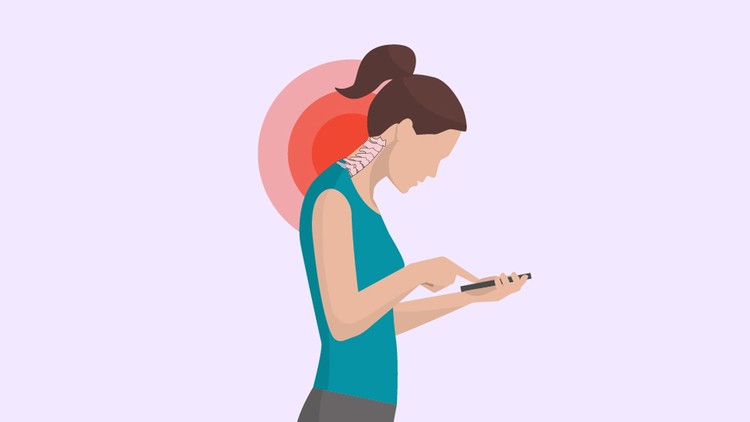We now spend a significant amount of time on our cellphones, computers, and tablets. According to studies, people spend about four hours each day gazing at their smartphones, equating to 1,400 hours per year. And, as we are scanning through our latest email, texts, or Whatsapp or Facebook updates, we are unconsciously putting our necks into an overstressed forward curve.
The term ‘Text neck’ was coined by US chiropractor Dr. Dean L. Fishman to characterize this frequent condition. The main highlight is what does text neck entail, and how does it impact your health? Meanwhile, this article will walk you through the fundamentals of the condition and how to manage and prevent it. To begin, you should know more about your cervical spine so that you can better grasp everything.
The Cervical Spine
Your cervical spine is a fancy name for your neck. It’s made up of seven small vertebrae and is the most movable and flexible part of your spine. It makes it so your head can move up and down and turn side to side. On top of that, your cervical spine has a natural lordotic curvature, which means it bends inward at your neck gently.
It helps even out the backward or kyphotic curve of your thoracic spine and helps balance the weight of your head evenly. Since your cervical spine is highly flexible, it’s also more vulnerable to pain and damage. And, one frequent source of this damage is text neck.
This is why our chiropractors here at Optimal Chiropractic advise people to come for a check-up when they notice discomfort around their cervical spine region.
The Basic Concepts of Text Neck
Text neck is a term that describes the pains and discomforts around the neck and is caused by staring down at your phone, tablet, or another wireless device for an extended period. Looking down at your phone exerts strain on the front and rear of your neck, thereby increasing the risk of spinal disc bulging. And it appears to be becoming more common. Of course, bending your neck to glance down is a common position that occurs while not texting.
The issue with texting is that it adds another activity that encourages us to look down, and it tends to be done for considerably longer lengths of time. It’s very troubling because young, growing children’s cervical spines could sustain an irreparable injury, resulting in lifelong neck pain.
Even if you have never heard of text neck, you must have probably experienced it. After gazing down at a game for too long or watching an episode of your favorite series, the tightness and tinge of pain creep up your neck and upper back. You probably don’t realize how many times a day you look down at your phone to respond to an email, send a text, or look for directions. And all of those small motions can add up to be a tremendous ache in the neck and eventually lead to significant problems.
According to multiple studies, the weight carried down the spine increases by 10 pounds for every inch forward you hold your head. Looking down strains the front of the neck and leaves a space in the back. This is particularly problematic since it can cause intervertebral discs to move backward, increasing the risk of disc bulges. It also puts a strain on the back of the neck, as the muscles on the rear are constantly contracting, attempting to pull and hold the head in this forward posture.
Muscle strain and soreness in the back of the neck result as a result of this, and it doesn’t end there. Text neck also causes tightness in the front of the neck and chest, causing discomfort or malfunction in the shoulders and middle back.
The Impact of Text Neck on Your Health
Generally, what a text neck can do to you is pains around the region of the neck. However, it doesn’t stop there because there are other problems it could cause. Let’s have a look at them below;
1. Structural Back and Neck Problems
As your posture deteriorates, the muscles in your upper back stretch out, and the muscles in your front body weaken, your neck moves forward, and your head feels ten pounds heavier. Tech neck can induce fear and respiratory problems in addition to structural back and neck problems. Maintaining a forward-rolled posture has a significant impact on your respiration.
2. Neck Strain
Using your mobile phone or laptop too much can put a lot of strain on your neck. A forward head position causes the muscles behind your neck to overstretch and the muscles in the front to shorten excessively. This is not only where most people store their tension, but it can also cause neck tightness, stiffness, and discomfort.
3. Shoulder Pain
You may also have shoulder pain in addition to the ache in your neck from texting on your smartphone. Because smartphones are so small, many people stoop their shoulders to hold their phones in one hand while texting with the other. Hunching over your keyboard can also be caused by poor ergonomics while sitting in front of your computer. You should stretch your shoulders out to give them a break and exercise forward, and backward shoulder rolls regularly.
4. Headaches
You may also get headaches if you look at your computer monitor with your head too far forward over your shoulders or if you look at your mobile phone display with your head tilted down. Either of these positions will cause your head to be unbalanced, resulting in headaches. Instead, try raising your phone to eye level and changing your seat so you’re sitting upright and your computer monitor is at eye level.
5. Stiffness
Inflammation and stress to your connective tissues and neck muscles can result in your tissue stiffening or hardening, thereby limiting your neck’s rotation.
6. Wear and Tear on the Spine
The more people rely on their handheld electronic gadgets, the more their postural health suffers as they move into their default posture for long periods every day. It can lead to degeneration, wear, and strain of the cervical spine over time. It could also necessitate spine surgery.
7. Long-term Complications
Long-term complications, similar to whiplash injuries, could include tension headaches, herniated discs in your cervical spine, and neck sprains. Initially, your muscles will have to work hard to keep your head upright. When your muscles contract, they put extra pressure on your discs, causing them to wear down faster. Your weaker discs may expand or even explode as a result. If a ruptured disc compresses one of your nerves, you may have arm weakness, pain, or numbness, which may necessitate surgical intervention.
8. Abnormal Curvature
If left untreated, the forward bending caused by staring at your screen could become permanent. In addition, if you do not exercise caution, you may develop an irreparable hunchback appearance.
Exercises That Counteract the Effects of Text Neck
Although you may not be able to avoid glancing down at your phone, there are exercises you can take to relieve some of the tension in your neck and back and prevent larger problems from developing.
Also, because individuals are so dependent on their phones, they lose a note of their posture since they are mentally immersed in their work. If you spend a lot of time in the text neck posture, you must spend at least as much time, if not more, in the opposite position to keep your neck balanced.
These exercises help to loosen up tight muscles in the chest, restore postural alignment, and improve muscular stabilizer action. Meanwhile, you can visit the chiropractor from Optimal Chiropractic in West Fargo to help you with these exercises. Let’s have a look at them below;
1. Chin Tuck
Chin tucking is a simple exercise that may be done at your desk, at a stoplight, or even at a work meeting. This easy stretch can help you become more aware of your spine while also strengthening the muscles in your neck, which will help you pull your head back into alignment.
To do so:
- Begin by sitting tall in a chair with your chin parallel to the ground.
- Draw your head and chin back softly, as if you’re producing a double chin, without tilting your head in any direction.
- Make sure your head isn’t pushed back. A stretch should be felt along the back of your neck.
- Imagine a cord pushing your head higher and actively elongating your neck, as if you were a robot.
- Push the base of your skull away from the base of your neck with your hands.
- Hold this position for three deep breaths while keeping your jaw relaxed.
- For a better result, release your chin forward and repeat the action.
2. Exaggerated Nod
By drawing your shoulders down and back and boosting neck mobility, the exaggerated nod counterbalances the downward/forward head position. To do so
- Sit with your head directly above your torso in a proper upright posture. Yes, nod your head to check the strength and flexibility in your topmost neck joint (your skull connecting to your cervical spine).
- Maintain a little double chin by holding the bottom of the nod.
- Do not nod so forcefully that you lose your breath or your chin becomes stuck in your throat.
- Hold for 10 seconds before releasing carefully.
3. Chest Opening
The goal of this exercise is to induce a slow and moderate lengthening of the chest and shoulder muscles, which is particularly efficient in counteracting the effects of a stiff neck. You’ll need two six-inch yoga blocks or two stacks of books, each six inches tall, to complete this practice.
- Place your hands behind your head and sit or stand.
- Squeeze your shoulder blades back and open your elbows out to the side.
- In the front of your chest, you should feel a stretch.
- Raise your head and shoulders backward gently to tilt your upper middle back to accentuate this.
- Hold for 10-20 seconds before releasing carefully.
4. Spinal Decompression/Postural Correction
Decompression of the Spine helps to relieve pressure on the joints and nerves. This is accomplished by widening the gap between your vertebrae or the gap between your vertebrae and nerves.
- Begin by sitting on the edge of your seat for this exercise.
- Separate your legs and turn your feet out at a 45-degree angle.
- Then, with your palms facing front, hang your arms lightly at your sides.
- In a neutral stance, sit up straight.
- Return your head to a position where it is directly over your shoulders.
- For a better result, take around 10 deep breaths in and out and repeat the process.
5. Bow Pose
Bow pose opens the shoulders from the front and strengthens them from the back, which helps combat slouched shoulders.
- Lie down on your stomach with your chin on the ground and your hands on each side.
- Bend your knees and bring your heels as near as you can to your buttocks.
- Grab your outer ankles with both hands as you reach backward.
- Lift your heels toward the ceiling as you inhale, lifting your chest, thighs, and upper torso off the mat.
- Lift your heels higher while maintaining your tailbone pressed against the mat to increase the stretch.
- Draw your shoulders away from your ears and look forward. Hold this stance for ten breaths.
- Exhale and slowly lower your thighs, followed by the rest of your body, to the floor.
How To Prevent Text Neck
Below are ways you can prevent text neck;
Adjust the Way You Hold Your Phone
Bring the screen up to eye level to avoid slouching forward or raising your head too high. Maintain a neutral spine with your ear in line with your shoulders instead. This will prevent you from maintaining a forward-head posture for too long.
Take Breaks from Your Phone
Even if it’s only two to three minutes every hour, taking frequent breaks from the screen can help. My first recommendation for preventing and alleviating text neck is to break the habit of looking down, but most people are unlikely to do so.
Instead, chiropractors advise that people try to intentionally disconnect from their phones. Use a sticky note or set a reminder on your phone or computer. These minor details can make a big difference.
Download The Text Neck App and Give It a Shot
In most smartphones, there’s a Text Neck app that gives you real-time feedback on your posture via a green or red light. A vibration or buzzer reminder is also available to alert you when you’ve reverted to old habits.
Practice Yoga For 10 Minutes
Yoga is the most effective treatment and prevention for neck and back pain because it improves movement patterns, develops body awareness, and involves breath practice. Neck pain is caused by a muscular imbalance, such as tight rhomboids, which can be corrected with daily yoga sessions. The activities listed above, as well as 10 minutes of yoga per day, can make a difference.
Final Words
The effect of text neck in the body is something that shouldn’t be overlooked because it can cause other underlying issues in the body if left untreated. It’s advisable to visit our Chiropractors in Fargo if you notice you feel pains around your cervical spine region. However, some exercises have also been shown to be very effective in treating this condition, and the ones outlined above are all very effective if done properly.




